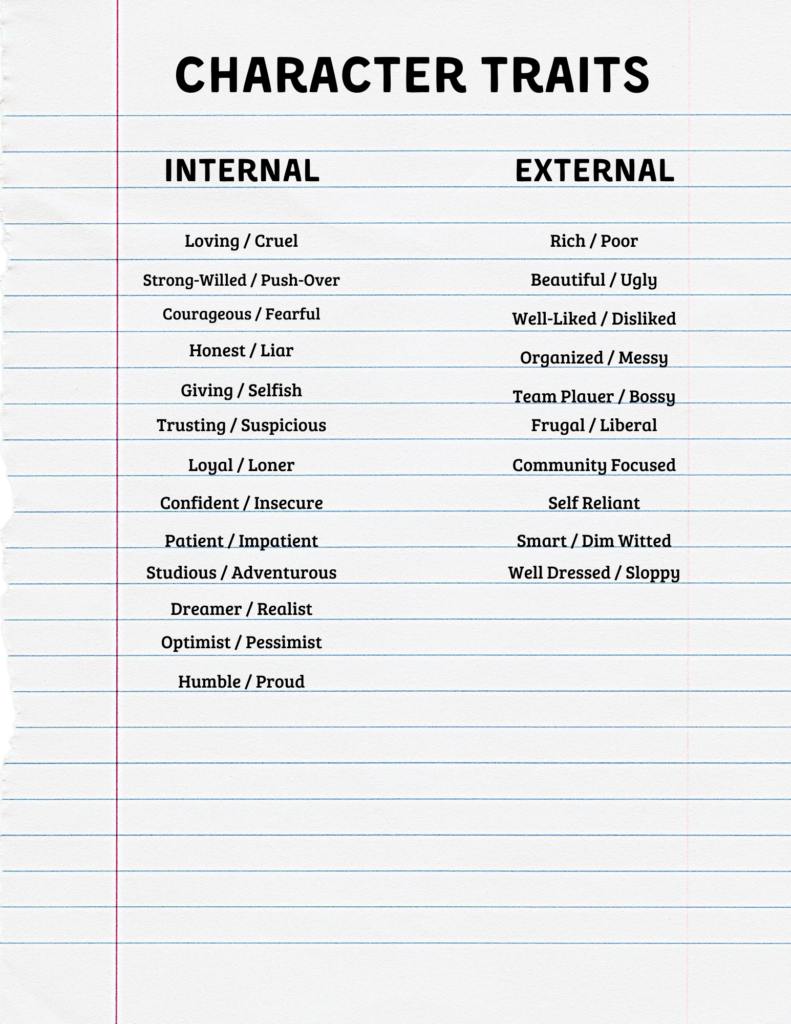I have been going through all of my old blog posts and updating them as necessary. Well, I came across a few posts that I did back in 2020 for Nanowrimo, regarding worldbuilding and character development. I thought it might be helpful to throw those worksheets up again for anyone that didn’t get a chance to download them the first time AND I’m adding a few new worksheets in. These are completely free, of course, and are intended to help you think more critically about how you design your characters and their world.
Start by Brainstorming Character Traits!
Whenever I design a new character, I like to imagine them in their environment. What do they care about? What traits do they have that interfere with them reaching their goals? Stories are often, if not always, led by character traits. Think about a children’s story where the child is scared of the dark. The goal of the story is probably the child overcoming that fear.
When I was working on my character Paige in The Disappearance of Susannah Dane, I made her somewhat nervous and in her attempts to overcome that feeling would go too far in the wrong direction (now becoming over-confident) and of course, this usually happens during pivotal moments in the story. She might feel afraid to confront the antagonist, but forces herself to push through that feeling anyway, putting herself in danger and moving the plot forward. This is just a small example of how I might use a character trait to determine how the character will navigate through situations.
This is just a super simple brainstorming diagram that you can use for yourself or your students. I like to use printables like this and keep them in a special binder. Then, when I’m writing, I can return to them. It is often easier to find a paper like this than it is to find one that I drew in pencil on a pizza napkin (but the napkin works just fine if printing is a challenge for you!)
If you need some help thinking up a character trait, consider a few of these internal and external traits. I think of internal traits as ones that the character is probably not as aware of, but these traits define the inner workings of your character and their motivation. External traits are obvious to your character and to the people that they interact with in the story. I wrote these are opposites but don’t feel that just because your character is loyal that they can’t be a loner. Or that it is impossible for them to be giving to their family and selfish with strangers. Some of these traits are not exclusive, but you should come up with a reason as to why they are important in the story.

Character Building Worksheet
You should have a somewhat clearer image of what your character is like. Now that you know who they are, let’s think about what they look like and what their world is like. This worksheet really focuses on the most important physical attributes of your character and drops them into the world.
For Paige, I would define her as Paige Parker, mouse-brown hair, brown eyes, white, freckles, tall, lanky, awkward. She has a knack for getting into trouble and is determined. The people most important to her are Zeze, Owen, her mom, and her step-brother Des. Her dream is to support herself doing a job that she enjoys. Her biggest fear is losing those that she loves. She was born in 2003 and a fictional event that matters to her was the death of her father. 3 things that will make her fail: 1. She is inexperienced. 2. She is nervous, lacks coping skills. 3. She is impulsive and will throw herself into situations before thinking them through all the way.
Worldbuilding Worksheet
This is a super simple worksheet, but I find it really helpful to just fill it out, especially when writing a series. In the first Paige Parker novel, the school year has just begun and summer is winding down. The second novel begins during Halloween. These are simple events but particularly for a high schooler, it is helpful to have a sense of time because holidays (and specifically, breaks from school) are very important to the story. The culture questions are really more for a fantasy book, but I find it helpful to list how each cultural element plays a part in the story. In The Disappearance of Susannah Dane, small-town politics keep the sheriff from investigating the teen girl’s disappearance. In The Absence of Aurelia Perez, racial discrimination and also cultural norms are both factors. This is a good spot to write in the sidebar or on a sticky note and remind yourself which elements are at play in your story.
Pin It to Save This Post For Later!
If you found this post helpful, go ahead and save this graphic on Pinterest to share with your writer friends or so that you remember where you found these printables the next time you write a story. Thanks for reading!






0 Comments